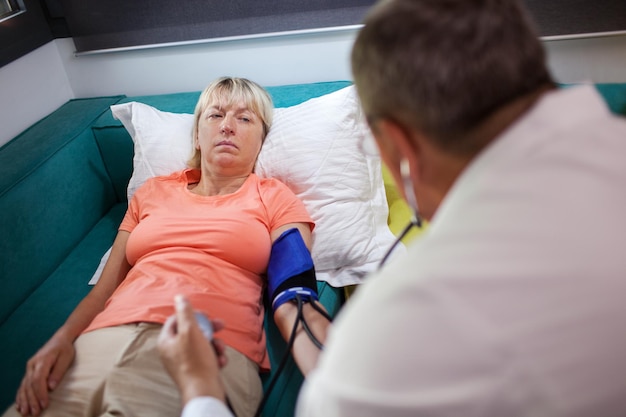A new study conducted by a team of researchers led by Mattias Tallroth and published in the Swedish Stroke Register offers significant insights into the effects of antithrombotic drugs on patients who suffer from intracerebral hemorrhage (ICH). The retrospective cohort study, titled “Antithrombotic Treatment and Clinical Outcomes After Intracerebral Hemorrhage,” analyzes data from over 13,000 ICH patients from 2017 to 2021 to investigate the prevalence of various antithrombotic drugs and their impact on patient outcomes.
Intracerebral hemorrhage is a severe form of stroke with high mortality and morbidity rates, often exacerbated by the use of antithrombotic treatments such as vitamin K antagonists and direct oral anticoagulants. The shift towards direct oral anticoagulants, which are associated with a lower risk of ICH, prompted researchers to assess their relative safety and effectiveness compared to traditional treatments. This study focuses on mortality and functional outcomes in those patients who were functionally independent before the stroke, adding valuable data about the risks associated with continued antithrombotic treatment after an ICH event.
The findings of this comprehensive study reveal complex outcomes regarding mortality and functional dependence, challenging previous assumptions about the safety profile of newer anticoagulant medications compared to older types and antiplatelet therapies. This necessary research could lead to improved clinical guidelines and patient care strategies, aiming to optimize treatment and increase survival rates among ICH patients.
Intracerebral hemorrhage (ICH) represents one of the most fatal types of stroke, accounting for 10-15% of all strokes but disproportionately responsible for a higher percentage of stroke-related morbidity and mortality. Unlike ischemic stroke, which is caused by a blockage in blood flow to the brain, ICH occurs when a weakened blood vessel ruptures and bleeds into the surrounding brain tissue. This bleeding causes damage to brain cells, and the accumulation of blood can lead to increased pressure within the skull, exacerbating the extent of brain injury.
Historically, the management of patients who suffer from ICH while on antithrombotic therapy—such as antiplatelets or anticoagulants—has been a complex clinical challenge. These medications are prescribed to prevent clotting, which is crucial in conditions like atrial fibrillation, mechanical heart valves, or prevention of myocardial infarction and other thromboembolic events. However, in the context of an ICH, the very action of these drugs—prevention of clotting—increases the risk of continued bleeding, potentially raising the mortality and worsening the outcome.
The dilemma faced by healthcare providers is determining the optimal balance between the risk of thrombosis due to cessation of antithrombotic drugs and the risk of further hemorrhagic events if these drugs are continued. This balance becomes especially precarious when considering the aging population and the rising prevalence of conditions that necessitate antithrombotic therapy, such as atrial fibrillation.
Over recent years, the advent of direct oral anticoagulants (DOACs) has shifted the landscape of antithrombotic treatment. Compared to traditional vitamin K antagonists (VKAs) like warfarin, DOACs offer a preferable safety profile, notably inducing a lower risk of intracranial bleeding. However, despite their advantages, the occurrence of ICH in patients taking DOACs still presents significant treatment challenges and negative outcomes. This ambiguity has driven researchers like Mattias Tallroth and his team to further investigate the correlation between various antithrombotic therapies and patient outcomes post-ICH.
The study conducted by Tallroth et al. is particularly important in light of these dynamics. By analyzing an extensive database from the Swedish Stroke Register, the researchers aim to delineate the nuances in survival rates, functional outcomes, and potential risks for patients who were previously functionally independent before experiencing an ICH. This investigation is crucial, as it may inform revisions in current medical guidelines and prescribing practices, potentially influencing a wide range of protocols for the management of patients with pre-existing cerebrovascular risks.
Understanding how these different antithrombotic agents influence the course and outcome of ICH is not only an academic necessity but a practical requirement to improve clinical outcomes and provide a basis for informed decision-making in clinical practice.
The methodology employed by Tallroth and his team in their retrospective cohort study analyzing antithrombotic treatment after intracerebral hemorrhage (ICH) was scrupulously designed to ensure that the research was as comprehensive and accurate as possible. Utilizing data from the Swedish Stroke Register, the study encompassed all recorded instances of ICH occurring from January 2017 to December 2021, amounting to a sample size exceeding 13,000 patients. The register provided a database robust in demographic details, medical history, type of antithrombotic agent used (if any), and subsequent clinical outcomes. This wealth of data enabled the researchers to make nuanced comparisons and draw insightful conclusions about the effects of antithrombotic treatments on ICH outcomes.
### Data Collection
From the register, data on variables such as age, gender, past medical history including prior strokes or thromboembolic events, type of antithrombotic treatment being administered at the time of ICH, and functional status prior to the ICH were collated. Key outcomes measured included mortality (at 30 days, 90 days, and 1 year post-ICH), functional dependence (based on modified Rankin Scale scores at hospital discharge and follow-up), and recurrent thromboembolic events or additional hemorrhagic episodes.
### Study Population
The researchers targeted adults who suffered from ICH while on antithrombotic therapy, filtering out cases that involved traumatic brain injury or other secondary causes of hemorrhage. The population was then subcategorized based on the specific antithrombotic agent they were receiving: vitamin K antagonists (VKAs), direct oral anticoagulants (DOACs), antiplatelets, and those who were not on any antithrombotic treatment at the time of their stroke.
### Treatment Stratification and Comparison Groups
Patients were grouped based on the type of antithrombotic therapy to analyze differences in outcomes among these groups. DOACs and VKAs were analyzed both collectively and separately to assess the nuanced differences between these drugs as well as in comparison to antiplatelet agents.
### Outcome Measures
The primary outcomes studied were mortality and functional dependence after the ICH event. Mortality rates were analyzed at different intervals to observe short-term and longer-term impacts. Functional outcomes were evaluated through the modified Rankin Scale, which rates the degree of disability or dependence in daily activities.
### Statistical Analysis
Using statistical software, survival analyses were conducted using Kaplan-Meier curves, and multivariable Cox proportional hazards models were adjusted for potential confounders like age, sex, hypertension, prior stroke, and the severity of the hemorrhage at presentation. Logistic regression was used to explore associations between the type of antithrombotic agent and the risk of subsequent hemorrhagic or thromboembolic events.
### Ethical Handling
This retrospective study was conducted following ethical guidelines, with data anonymization and appropriate approvals from review boards to ensure patient confidentiality and compliance with medical research standards.
### Conclusion
The methodology of Tallroth’s study highlights its rigor and thoroughness in dealing with a complex clinical question. By employing robust statistical tools and a comprehensive dataset, the researchers aimed to provide clearer insights into the impacts of various antithrombotic treatments post-ICH, guiding future clinical decision-making processes in this challenging area of stroke management.
### Key Findings and Results
The research findings of Tallroth and his team shed new light on the clinical outcomes following intracerebral hemorrhage (ICH) in patients undergoing antithrombotic treatment. The study’s conclusions provide critical insights critical for refining treatment protocols and optimizing patient care.
#### Mortality Outcomes
One of the most significant revelations concerns the mortality rates associated with different antithrombotic therapies. The study found that patients on direct oral anticoagulants (DOACs) demonstrated lower short-term mortality rates compared to those on vitamin K antagonists (VKAs). At 30-day and 90-day post-ICH checkpoints, the mortality rates were significantly reduced in the DOAC group. This finding supports the notion that DOACs, despite their association with ICH, might offer a safer profile in terms of immediate survival.
However, the long-term survival rates (analyzed at the 1-year mark) did not significantly differ between patients taking DOACs and those on VKAs, suggesting that while DOACs might offer initial benefits, these advantages may not persist over time. This aspect of the discovery is particularly insightful, indicating that while DOACs might reduce the immediate risk post-ICH, comprehensive long-term management strategies need attention.
#### Functional Outcomes
In terms of functional dependence, the study revealed a nuanced picture. Patients treated with antiplatelet agents before the ICH tended to have better functional outcomes at discharge and during follow-ups than those on anticoagulants (DOACs or VKAs). This suggests that while antiplatelets may confer a higher risk of ICH compared to DOACs, they may be associated with less severe ICH or better recovery post-event.
One critical aspect of the study was comparing functional outcomes among patients who resumed antithrombotic therapy post-ICH to those who did not. Interestingly, resuming antithrombotic treatment was associated with a lower risk of death and major adverse cardiovascular events without significantly worsening functional outcomes. This counterintuitive result underscores the complexity of managing ICH patients, particularly those at high risk for thromboembolic events.
#### Recurrence and Additional Complications
The researchers also explored the recurrence rates of ICH and other thromboembolic complications based on the type of antithrombotic therapy. The data indicated an overall lower recurrence rate of ICH in the cohort treated with DOACs compared to those on VKAs, aligning with the literature suggesting a safer profile of DOACs concerning intracranial hemorrhage. However, the risk of thromboembolic events remained comparably high across all groups, showing the challenge of balancing antithrombotic benefits against hemorrhagic risks.
### Implications for Clinical Practice
These findings are poised to influence future guidelines significantly and clinical practices surrounding the management of ICH in patients who require antithrombotic therapy. The results suggest a potential paradigm shift towards favoring DOACs over VKAs for those at risk of ICH due to their favorable short-term mortality outcomes. Additionally, the data on resuming antithrombotic treatment post-ICH could help refine decisions about when and how to reintroduce these medications.
Overall, the study by Mattias Tallroth and colleagues provides compelling evidence that will aid in the development of more nuanced, patient-specific treatment strategies. It highlights the importance of individualized patient assessments and the potential benefits of personalized medicine in managing ICH survivors, particularly those with complicating co-morbidities that necessitate ongoing antithrombotic therapy. These insights are invaluable for clinicians navigating the complexities of treating acute stroke incidents while considering long-term cardiovascular health and functional integrity.
### Future Directions and Final Thoughts
The groundbreaking study led by Mattias Tallroth has unveiled crucial insights into the management of intracerebral hemorrhage (ICH) in patients undergoing antithrombotic therapy, paving the way for transformative approaches in stroke care. However, this research also highlights areas where further investigation is needed to refine treatment strategies and optimize patient outcomes further.
#### Research on Long-term Management and Monitoring
While the current study significantly contributes to understanding short-term outcomes after ICH, the nuances of long-term management remain less clear. Future research could focus on longitudinal studies that track patients over several years to understand better the chronic impacts of different antithrombotic therapies post-ICH. Such studies would help clarify the long-term survival and neurofunctional trajectories of these patients, providing deeper insights into the chronic phases of recovery and medication management.
#### Personalized Medicine Approaches
The variability in outcomes based on the type of antithrombotic therapy suggests a potential for personalized medicine in managing ICH patients. Further studies could explore genetic, physiological, and lifestyle factors that may influence individual responses to different antithrombotic treatments. This line of research could lead to more tailored therapy choices, maximizing efficacy while minimizing risks for specific patient groups.
#### Comparative Studies Between Antithrombotic Agents
The comparative effectiveness and safety profiles of DOACs versus VKAs highlighted in this study invite further comparative analyses. Future research could expand to include newer antithrombotic agents and those currently under development, offering a broader understanding of the landscape of available treatments and their implications for ICH management.
#### Integration of New Technologies
Advances in technology, such as artificial intelligence and machine learning, could be utilized to predict outcomes and optimize treatment plans for ICH patients on antithrombotic therapy. These technologies have the potential to analyze large datasets to identify patterns and predict risks, potentially guiding clinical decision-making in real-time.
#### Implementation Science
Given the implications of this research on clinical guidelines, there is a critical need for studies focusing on implementation science. These would evaluate how new evidence can be best translated into routine clinical practice, ensuring that the findings lead to tangible improvements in patient care. Exploration of barriers to application and strategies for effective dissemination of updated guidelines will be crucial.
### Closing Thoughts
The inquiry led by Tallroth and his team marks an essential step forward in understanding the interplay between antithrombotic treatment and outcomes in ICH patients. Their findings challenge existing paradigms and invite a re-examination of clinical practices that could significantly impact patient care quality and prognosis following one of the most devastating forms of stroke. As we move forward, it is imperative that the clinical community embraces these insights, advocating for ongoing research and adaptation of clinical practices to ensure that each patient receives the most informed and precise treatment possible.
The road ahead involves not only further scientific inquiry but also a robust dialogue among clinicians, researchers, patients, and policy-makers to redefine how we manage the acute and long-term care of patients at the intersection of cerebrovascular incident and antithrombotic therapy. This study’s implications are far-reaching, promising to influence guidelines and practices not just within neurology but across multiple disciplines involved in cardiovascular and cerebrovascular patient care.









